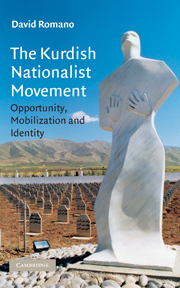Book contents
- Frontmatter
- Contents
- Acknowledgments
- List of acronyms and abbreviations
- Map
- 1 Making sense of ethnic nationalist resurgence
- 2 Structural conditions and political opportunities
- 3 Resource mobilization and rational choices
- 4 Cultural framing
- 5 Theoretical synthesis
- 6 Kurdish nationalist challenges to the Iraqi state
- 7 Kurdish nationalist challenges to the Iranian state
- 8 Conclusion
- Bibliography
- Index
- Cambridge Middle East Studies 22
7 - Kurdish nationalist challenges to the Iranian state
Published online by Cambridge University Press: 14 January 2010
- Frontmatter
- Contents
- Acknowledgments
- List of acronyms and abbreviations
- Map
- 1 Making sense of ethnic nationalist resurgence
- 2 Structural conditions and political opportunities
- 3 Resource mobilization and rational choices
- 4 Cultural framing
- 5 Theoretical synthesis
- 6 Kurdish nationalist challenges to the Iraqi state
- 7 Kurdish nationalist challenges to the Iranian state
- 8 Conclusion
- Bibliography
- Index
- Cambridge Middle East Studies 22
Summary
The early Iranian state and the Simko revolt
The events surrounding World War One did not witness a disintegration of lands held by the Iranian monarchy in the way they did for the Ottoman empire. Nonetheless, the Iranian state at the time did not effectively control much of the countryside. Parts of Iranian Kurdistan which had been tenuously ruled by Iran since 1639 (when an Ottoman–Safavid treaty ceded some of the Kurdish regions to the Ottomans), rose up in rebellion. Around the same time as the Kuchgiri, Sheikh Said, and Barzinji revolts in Turkey and Iraq, Ismail Agha Simko led the most major Kurdish revolt in Iran at the time. A feudal tribal agha with a villainous reputation for being more of a warlord than a genuine nationalist, Simko first subdued and plundered the Kurdish, Azeri, and Assyrian groups in his region around Lake Uromiyah. These groups and their leaders might otherwise have emerged as competitors to Simko. In an attempt to take advantage of what he saw as Iranian state weakness (lack of coercive capacity and divisions amongst the capital's elites), Simko then declared an independent Kurdish state in the area under his control, proclaiming his actions to be a prelude to independence for all of Kurdistan. Simko held the area against the Iranian army for four years, and even met in 1923 with fellow Kurdish sheikh Mahmoud Barzinji (described in Chapter 6 on Iraqi Kurdistan, Barzinji and Simko had some similarities in style and followings) to coordinate strategies.
- Type
- Chapter
- Information
- The Kurdish Nationalist MovementOpportunity, Mobilization and Identity, pp. 222 - 247Publisher: Cambridge University PressPrint publication year: 2006



